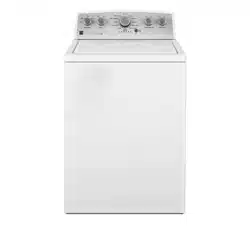Documents: Go to download!
User Manual
- User Manual - (English, French, Spanish)
- Product Data Sheet 1 - (English)
- Manufacturer Warranty - (English)
- Energy Guide - (English)
- WHAT'S NEW UNDER THE LID?
- CONTROL PANEL AND FEATURES
- CYCLE GUIDE
- USING YOUR WASHER
- WASHER MAINTENANCE
- TROUBLESHOOTING
Table of contents
User manual Washer
WHAT'S NEW UNDER THE LID?
Cleaning with Less Water
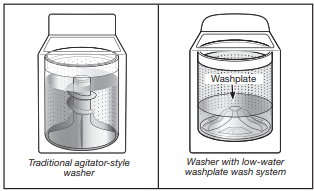
The most striking difference in your new washer is the low-water washplate wash system. The washer automatically adjusts the water level to the load size—no water level selector is needed.
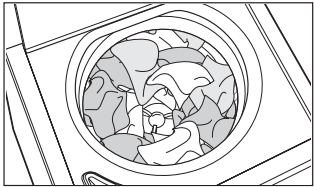
For best performance, it is recommended to load items in loose heaps evenly around the washplate.
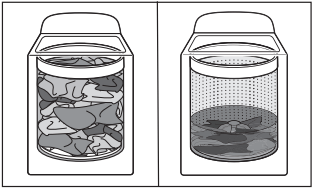
As the washer dampens and moves the load, the level of the items will settle in the basket. This is normal, and does not indicate that more items should be added.
IMPORTANT: You will not see a washer basket full of water as with your past agitator-style washer. It is normal for some of the load to be above the water line.
Automatic Load Size Sensing
Once you start the cycle, the lid will lock, and the washer will begin the sensing process to determine the correct water level for the load. This may take several minutes before water is added. You will find a step-by-step description in the “Cycle Status Lights” section.
Initially the basket will start to spin prior to adding water, this is part of the sensing process and is normal. This low-water wash method uses less water and energy compared to a traditional agitator-style washer.
Choosing the Right Detergent
Use only High Efficiency detergents. The package will be marked “HE” or “High Efficiency.” Low-water washing creates excessive sudsing with a regular non-HE detergent. Using regular detergent will likely result in longer cycle times and reduced rinsing performance. It may also result in component failures and noticeable mold or mildew. HE detergents are made to produce the right amount of suds for the best performance. Follow the manufacturer’s instructions to determine the amount of detergent to use.

Use only High Efficiency (HE) detergent.
Improved Cleaning
Low-water cleaning means concentrated cleaning. Rather than diluting detergent as done in an agitator-style washer, this washer delivers the detergent directly to the soils. This low water wash also allows the clothing to move in a more effective way to remove soils.
Normal Sounds You Can Expect
At different stages of the wash cycle, you may hear sounds and noises that are different from those of your previous washer. For example, you may hear a clicking and hum at the beginning of the cycle, as the lid lock goes through a self-test. There will be different kinds of humming and whirring sounds as the washplate moves the load and as basket is decelerating to stop. And sometimes, you may hear nothing at all, as the washer determines the correct water level for your load or allows time for clothes to soak.
CONTROL PANEL AND FEATURES

1. WASH TEMP
Wash Temp senses and maintains uniform water temperatures by regulating incoming hot and cold water.
Select a wash temperature based on the type of fabric and soils being washed. For best results and following the garment label instructions, use the warmest wash water safe for your fabric.
- On some models and cycles, warm and hot water may be cooler than your previous washer.
- Even in a cool and cold water wash, some warm water may be added to the washer to maintain a minimum temperature.
2. CYCLE OPTIONS
The following options may be added to most cycles. See “Cycle Guide” for additional details.
RINSE
This option can be used to automatically add a second rinse to most cycles.
FABRIC SOFTENER
This option must be set to “On” if using fabric softener during a cycle. It ensures that fabric softener is added at the correct time in the rinse for even distribution.
STAINBOOST
This option provides enhanced cleaning action for tough stains. It will add additional spin and soak time to the cycle.
3. WASH CYCLE KNOB
Use the Wash Cycle knob to select available cycles on your washer. Turn the knob to select a cycle for your laundry load. See “Cycle Guide” for detailed descriptions.
4. START/PAUSE/UNLOCK LID
Press to start the selected cycle; press again to pause the cycle and unlock the lid.
Press and hold 3 seconds to cancel a cycle and drain the water from the washer.
NOTE: If the washer is spinning, it may take several minutes to unlock the lid.
5. CYCLE STATUS LIGHTS

The Cycle Status Lights show the progress of a cycle. At each stage of the process, you may notice sounds or pauses that are different from traditional washers.
SENSING
When the START/PAUSE/Unlock Lid is pressed, the washer will first perform a self-test on the lid lock mechanism. You will hear a click, the basket will make a slight turn, and the lid will unlock briefly before locking again.
Once the lid has locked the second time, the washer will use short, slow spins to estimate the load size. These sensing spins may take 2 to 3 minutes before water is added to the load and you may hear the hum of these spins. If the sensing light is on, then washer is working properly. You will hear the motor turn the basket in short pulses to thoroughly wet the load. The washer will then move the load briefly, pause to allow water to soak in to the load, and resume adding water. This process may repeat until the correct amount of water has been added for the load. You may also hear water flowing through the dispenser, adding detergent to the load.
NOTE: Avoid opening the lid during sensing. The sensing process will start over when the washer is restarted. The sensing light may also come on during the Soak and Wash portions of the cycle. This is normal.
WASH
You will hear the motor and washplate moving the load. Unlike traditional washers, the load is not covered with water. Low-water cleaning means concentrated cleaning. Rather than diluting detergent as done in an agitator-style washer, this washer delivers the detergent directly to the soils. The motor sounds may change at different stages in the cycle.
RINSE
You will hear sounds similar to the wash cycle as the washer rinses and moves the load. You may hear the motor turning on briefly (short hum) to move the basket while filling. When Fabric Softener-On option is selected, additional water is added to the rinse to improve fabric softener distribution.
SPIN
The washer spins the load at increasing speeds for proper water removal, based on the selected cycle and spin speed.
COMPLETE
Once the cycle is complete, this light will come on. Remove the load promptly for best results.
LID LOCKED
To allow for proper load sensing and spinning, the lid will lock and the Lid Locked light will turn on. This light indicates that the lid is locked and cannot be opened.
If you need to open the lid, press START/ PAUSE/Unlock Lid. The lid will unlock once the washer movement has stopped. This may take several minutes if the load was spinning at high speed. Press START/PAUSE/Unlock Lid again to resume the cycle.
NOTE: If you hold the button for 3 seconds, the cycle will cancel and the water will drain.

CYCLE GUIDE
For best fabric care, choose the cycle that best fits the load being washed. Recommended settings for best performance are shown in Bold. Not all settings and options are available on each cycle.


NOTE: If you are using fabric softener, be sure to select Fabric Softener-On option.
*All rinses are cold.
USING YOUR WASHER
1. Sort and prepare your laundry
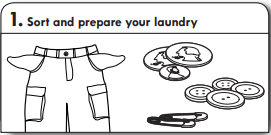
- Empty pockets. Loose change, buttons, or any small object can pass under the washplate and become trapped, causing unexpected sounds.
- Sort items by recommended cycle, water temperature, and colorfastness.
- Separate heavily soiled items from lightly soiled.
- Separate delicate items from sturdy fabrics.
- Do not dry items if stains remain after washing, because heat can set stains into fabric.
- Treat stains promptly.
- Close zippers, fasten hooks, tie strings and sashes, and remove non-washable trim and ornaments.
- Mend rips and tears to avoid further damage to items during washing.
Helpful Tips:
- When washing water-proof or water-resistant items, load evenly. See “Cycle Guide” for tips and more information on using the Bulky/Bedding cycle.
- Use mesh garment bags to help avoid tangling when washing delicate or small items.
- Turn knits inside out to avoid pilling. Separate lint-takers from lint-givers. Synthetics, knits, and corduroy fabrics will pick up lint from towels, rugs, and chenille fabrics.
Always read and follow fabric care label instructions to avoid damage to your items.
2. Add laundry products
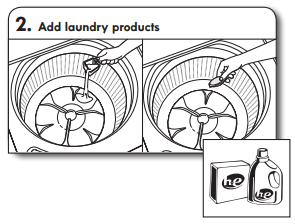
Add a measured amount of HE detergent or single-dose laundry packet into the basket.
If using Oxi-type boosters, color-safe bleach, or fabric softener crystals, add to the bottom of the washer basket before adding clothes.
IMPORTANT: Use only High Efficiency detergents. The package will be marked “HE” or “High Efficiency.” Low-water washing creates excessive sudsing with a regular non-HE detergent. Using regular detergent will likely result in longer cycle times and reduced rinsing performance. It may also result in component failures and noticeable mold or mildew. HE detergents are made to produce the right amount of suds for the best performance.
NOTE: Follow the manufacturer’s instructions to determine the amount of laundry products to use.
3. Load laundry into washer

For best performance, load items in loose heaps evenly around the washplate. Try mixing different sized items to reduce tangling.
IMPORTANT: Items need to move freely. Tightly packed items can lead to poor cleaning performance, and may increase wrinkling and tangling.
4. Add liquid chlorine bleach to dispenser
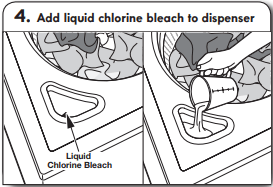
Do not overfill, dilute, or use more than 1 cup (250 mL). Do not use color-safe bleach or Oxi products in the same cycle with liquid chlorine bleach.
5. Add fabric softener

To dispense fabric softener in the rinse cycle, this washer has been designed to allow the use of the Downy Ball®† dispenser. Pour a measured amount of Downy® liquid fabric softener into the Downy Ball® dispenser, pull the ring tightly to seal it, and place on top of load. Always follow manufacturer’s directions for correct amount of fabric softener based on your load size. Then select Fabric Softener-On option. The Downy Ball® dispenser will automatically release the fabric softener during the rinse cycle.
IMPORTANT: Fabric Softener option must be selected to “On” to ensure proper distribution at correct time in cycle. Do not overfill or dilute.
Adding Liquid Fabric Softener Manually to Wash Load
During the final rinse, wait until the washer has completed filling, press the START/PAUSE/Unlock Lid button to pause the washer. Lift the lid and add the measured recommended amount of liquid fabric softener. Do not use more than the recommended amount. Close the lid and press the START/PAUSE/Unlock Lid button again to start the washer.
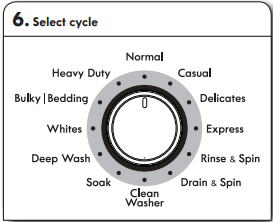
Turn cycle knob to choose your wash cycle.
7. Select wash temperature
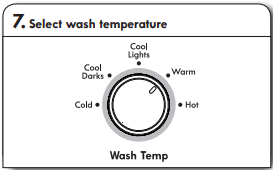
Once you select a cycle, select the wash temperature by turning the Wash Temp knob to the desired setting.
Always read and follow fabric care label instructions to avoid damage to your items.
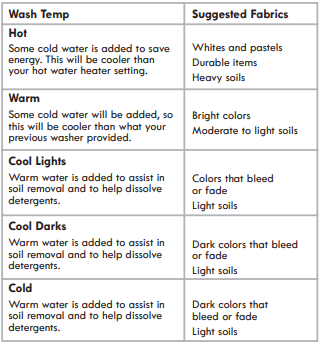
8. Select cycle options, if desired
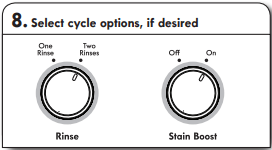
If you would like to add Two Rinses and/or use the STAINBOOST option, turn the knob for that feature.
The STAINBOOST option provides enhanced cleaning action for tough stains. It will add additional agitation and soak time to the cycle.
9. Press START/Pause/Unlock Lid to begin wash cycle
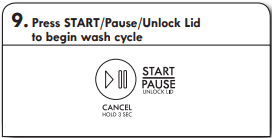
Press the START/PAUSE/Unlock Lid button to start the wash cycle. When the cycle has finished, the COMPLETE indicator will light. Promptly remove items after cycle has completed to avoid odor, reduce wrinkling, and rusting of metal hooks, zippers, and snaps.
Unlocking the lid to add items
If you need to open the lid to add 1 or 2 missed items:
Press START/PAUSE/Unlock Lid; the lid will unlock once the washer movement has stopped. This may take several minutes if the load was spinning at high speed. Then close lid and press START/PAUSE/Unlock Lid again to restart the cycle.
If lid is left open for more than 10 minutes, the water will pump out automatically.
WASHER MAINTENANCE
WATER INLET HOSES
Replace inlet hoses after 5 years of use to reduce the risk of hose failure. Periodically inspect and replace inlet hoses if bulges, kinks, cuts, wear, or leaks are found.
When replacing your inlet hoses, mark the date of replacement on the label with a permanent marker.
NOTE: This washer does not include inlet hoses. See the “Installation Instructions” for more information.
WASHER CARE
Recommendations to Help Keep Your Washer Clean and Performing at its Best
1. Always use High Efficiency (HE) detergents and follow the HE detergent manufacturer’s instructions regarding the amount of HE detergent to use. Never use more than the recommended amount because that may increase the rate at which detergent and soil residue accumulate inside your washer, which in turn may result in undesirable odor.
2. Use warm and hot wash water settings sometimes (not exclusively cold water washes), because they do a better job of controlling the rate at which soils and detergent accumulate.
3. Always leave the washer lid open between uses to help dry out the washer and prevent the buildup of odor-causing residue.
Cleaning Your Top Loading Washer
Read these instructions completely before beginning the routine cleaning processes recommended below. This Washer Maintenance Procedure should be performed, at a minimum, once per month or every 30 wash cycles, whichever occurs sooner, to control the rate at which soils and detergent may otherwise accumulate in your washer.
Cleaning the Inside of the Washer
To keep your washer odor-free, follow the usage instructions provided above, and use this recommended monthly cleaning procedure:
Clean Washer Cycle
This washer has a special cycle that uses higher water volumes in combination with liquid chlorine bleach to clean the inside of the washer.
Begin procedure
1. Chlorine Bleach Procedure:
a. Open the washer lid and remove any clothing or items.
b. Add 1 cup (236 mL) of liquid chlorine bleach to the bleach compartment.
NOTE: Use of more liquid chlorine bleach than is recommended above could cause washer damage over time.
c. Close the washer lid.
d. Do not add any detergent or other chemical to the washer when following this procedure.
e. Select the CLEAN WASHER cycle.
f. Press the START/Pause/Unlock Lid button to begin the cycle. The Clean Washer Cycle Operation is described below.
NOTE: For best results, do not interrupt cycle. If cycle must be interrupted, press POWER/CANCEL. (For models with no POWER/CANCEL button, press and hold START/ Pause/Unlock Lid for three seconds). After the Clean Washer cycle has stopped, run a RINSE/SPIN cycle to rinse cleaner from washer.
Description of Clean Washer Cycle Operation:
1. This cycle will fill to a water level higher than in normal wash cycles to provide rinsing at a level above the water line for normal wash cycle.
2. During this cycle, there will be some agitation and spinning to increase the removal of soils.
After this cycle is complete, leave the lid open to allow for better ventilation and drying of the washer interior.
Cleaning the Dispensers
After a period of using your washer, you may find some residue buildup in the washer’s dispensers. To remove residue from the dispensers, wipe them with a damp cloth and towel dry. Do not attempt to remove the dispensers or trim for cleaning. The dispensers and trim are not removable. If your model has a dispenser drawer, however, remove the drawer and clean it before or after you run the Clean Washer cycle. Use an all-purpose surface cleaner, if needed.
Cleaning the Outside of the Washer
Use a soft, damp cloth or sponge to wipe away any spills. Use only mild soaps or cleaners when cleaning external washer surfaces.
IMPORTANT: To avoid damaging the washer’s finish, do not use abrasive products.
NON-USE AND VACATION CARE
Operate your washer only when you are home. If moving, or not using your washer for a period of time, follow these steps:
1. Unplug or disconnect power to washer.
2. Turn off water supply to washer, to avoid flooding due to water pressure surge.
WINTER STORAGE CARE
IMPORTANT: To avoid damage, install and store washer where it will not freeze. Because some water may stay in hoses, freezing can damage washer. If storing or moving during freezing weather, winterize your washer.
To winterize washer:
1. Shut off both water faucets; disconnect and drain water inlet hoses.
2. Put 1 qt. (1 L) of R.V.-type antifreeze in basket and run washer on RINSE & SPIN cycle for about 30 seconds to mix antifreeze and remaining water.
3. Unplug washer or disconnect power.
TRANSPORTING YOUR WASHER
1. Shut off both water faucets. Disconnect and drain water inlet hoses.
2. If washer will be moved during freezing weather, follow WINTER STORAGE CARE directions before moving.
3. Disconnect drain hose from drain system and drain any remaining water into a pan or bucket. Disconnect drain hose from back of washer.
4. Unplug power cord.
5. Place inlet hoses and drain hose inside washer basket.
6. Drape power cord over edge and into washer basket.
7. Place packing tray from original shipping materials back inside washer. If you do not have packing tray, place heavy blankets or towels into basket opening. Close lid and place tape over lid and down front of washer. Keep lid taped until washer is placed in new location. Transport washer in upright position. Transport washer in upright position.
REINSTALLING/USING WASHER AGAIN
To reinstall washer after non-use, vacation, winter storage, or moving:
1. Refer to Installation Instructions to locate, level, and connect washer.
2. Before using again, run washer through the following recommended procedure:
To use washer again:
1. Flush water pipes and hoses. Reconnect water inlet hoses. Turn on both water faucets.
2. Plug in washer or reconnect power.
3. Run washer through BULKY/BEDDING cycle to clean washer and remove antifreeze, if used. Use only HE High Efficiency detergent. Use 1/2 the manufacturer’s recommended amount for a medium-size load.
TROUBLESHOOTING
First try the solutions suggested here for assistance and to possibly avoid a service call.
Vibration or Off-Balance
Check the following for proper installation or see “Using Your Washer” section.
- Feet may not be in contact with the floor and locked.
Front and rear feet must be in firm contact with floor, and washer must be level to operate properly. See “Installation Instructions”.
- Washer may not be level.
Check floor for flexing or sagging. If flooring is uneven, a 3/4" (19 mm) piece of plywood under your washer will reduce sound.
See “Level the Washer” in Installation Instructions.
- Load could be unbalanced.
Load items in loose heaps evenly around the washplate. Adding wet items to washer or adding more water to basket could unbalance washer.
Wash smaller loads to reduce imbalance.
Do not tightly pack. Avoid washing single items.
Use Bulky/Bedding cycle for oversized, non-absorbent items such as small comforters or poly-filled jackets.
See “Cycle Guide” and “Using Your Washer” in this Use and Care Guide.
Noises
Clicking or metallic noises
- Objects caught in washer drain system.
Empty pockets before washing. Loose items such as coins could fall between basket and tub or may block pump. It may be necessary to call for service to remove items.
It is normal to hear metal items on clothing such as metal snaps, buckles, or zippers touch against the stainless steel basket.
Gurgling or humming
- Washer may be draining water.
It is normal to hear the pump making a continuous humming sound with periodic gurgling or surging as final amounts of water are removed during the Drain & Spin cycles.
Humming
- Load sensing may be occuring.
You may hear the hum of the sensing spins after you have started the washer. This is normal.
Whirring
- Basket deceleration may be occurring.
You may hear the whirring sound of the basket decelerating. This is normal.
Water Leaks
Check the following for proper installation:
- Washer not level.
Water may splash off basket if washer is not level. Check that load is not unbalanced or tightly packed.
- Fill hoses not attached tightly.
Tighten fill-hose connection.
- Fill hose washers.
Make sure all four fill hose flat washers are properly seated.
- Drain hose connection.
Pull drain hose from washer cabinet and properly secure it to drainpipe or laundry tub.
Do not place tape over drain opening.
- Check household plumbing for leaks or clogged sink or drain.
Water can back up out of a clogged sink or drainpipe. Check all household plumbing for leaks (laundry tubs, drain pipe, water pipes, and faucets.)
- Washer not loaded as recommended.
Unbalanced loading can cause basket to be out of alignment and cause water to splash off tub. See “Using Your Washer” for loading instructions.
Washer not performing as expected
Not enough water in washer
- Load not completely covered in water.
This is normal operation for an HE low-water washer. The load will not be completely underwater. The washer senses load sizes and adds correct amount of water for optimal cleaning. See “What’s New under the Lid.”
IMPORTANT: Do not add more water to washer.
Washer won’t run or fill, washer stops working, or wash light remains on (indicating that the washer was unable to fill appropriately)
- Check for proper water supply
Both hoses must be attached and have water flowing to inlet valve.
Both hot and cold water faucets must be turned on.
Check that inlet valve screens have not become clogged.
Check for any kinks in inlet hoses, which can restrict water flow.
- Check proper electrical supply
Plug power cord into a grounded 3 prong outlet.
Do not use an extension cord.
Ensure there is power to outlet.
Reset a tripped circuit breaker. Replace any blown fuses. NOTE: If problems continue, contact an electrician.
- Normal washer operation
Lid must be closed for washer to run.
Washer will pause during certain phases of cycle. Do not interrupt cycle.
Washer may be stopped to reduce suds.
- Washer may be tightly packed.
Remove several items, rearrange load evenly in basket, and add detergent. Close lid and press START/PAUSE/Unlock Lid.
Do not add more than 1 or 2 additional items after cycle has started.
Do not add more water to the washer.
- Not using HE detergent or using too much HE detergent.
Only use HE detergent. Suds from regular detergents can slow or stop the washer. Always measure detergent and follow detergent directions based on your load requirements.
To remove suds, cancel cycle. Select Rinse & Spin. Press START/ PAUSE/Unlock Lid. Do not add more detergent.
Washer not draining/ spinning, loads are still wet, or spin light remains on (indicating that the washer was unable to pump out water within 10 minutes)
- Small items may have been caught in pump or between basket and tub, which can slow draining.
Empty pockets and use garment bags for small items.
- Used a cycle with a low spin speed.
Cycles with lower spin speeds remove less water than cycles with high spin speeds. Use the recommended cycle/spin speed for your item. To remove extra water in the load, select Drain/Spin. Load may need to be rearranged to allow even distribution of the load in the basket.
- The washer may be tightly packed or unbalanced.
Tightly packed or unbalanced loads may not allow the washer to spin correctly, leaving the load wetter than normal. Evenly arrange the wet load for balanced spinning. Select the Drain & Spin cycle to remove excess water. See “Using Your Washer” for loading recommendations.
- Check plumbing for correct drain hose installation. Drain hose extends into standpipe farther than 4.5" (114 mm).
Check drain hose for proper installation. Use drain hose form and securely attach to drainpipe or tub. Do not tape over drain opening. Lower drain hose if the end is higher than 96" (2.4 m) above the floor. Remove any clogs from drain hose.
- Too much detergent causing suds to slow or stop draining and spinning.
Use only HE detergent. Always measure and follow detergent directions for your load. To remove extra suds, select Rinse & Spin. Do not add detergent.
Dry spots on load after cycle
- High speed spins extract more moisture than traditional top-load washers.
The high spin speeds combined with air flow during the final spin can cause items near the top of the load to develop dry spots during the final spin. This is normal.
Incorrect or wrong wash or rinse temperatures
- Check for proper water supply
Make sure hot and cold inlet hoses are not reversed.
Both hoses must be attached to both washer and faucet, and have both hot and cold water flowing to inlet valve.
Check that inlet valve screens are not clogged.
Remove any kinks in hoses.
Load not rinsed
- Check for proper water supply
Make sure hot and cold inlet hoses are not reversed.
Both hoses must be attached and have water flowing to the inlet valve.
Both hot and cold water faucets must be on.
Inlet valve screens on washer may be clogged.
Remove any kinks in the inlet hose.
- Not using HE detergent or using too much HE detergent.
The suds from regular detergent can keep washer from operating correctly.
Use only HE detergent. Be sure to measure correctly.
Always measure detergent and follow detergent directions based on load size and soil level.
- Washer not loaded as recommended.
The washer is less efficient at rinsing when load is tightly packed.
Load items in loose heaps evenly around the washplate. The washer will not rinse well if tightly packed. Load with dry items only.
Use cycle designed for the fabrics being washed.
Add only 1 or 2 items after washer has started.
Sand, pet hair, lint, etc. on load after washing
- Heavy sand, pet hair, lint, and detergent or bleach residues may require additional rinsing.
Add a Two Rinses to the selected cycle.
Load is tangling
- Washer not loaded as recommended.
See “Using Your Washer” section.
Select a cycle with a slower wash action and spin speed; however, items will be wetter than those using a higher speed spin. See the “Cycle Guide” to match your load with the best cycle.
Load items in loose heaps evenly around the washplate.
Reduce tangling by mixing types of load items. Use the recommended cycle for the type of items being washed.
Not cleaning or removing stains
- Added more water to washer.
Washer senses load size and adds correct amount of water. This is normal and necessary for clothes to move. It is normal for the wash load to be not completely covered in water. Added water lifts the laundry off the washplate, resulting in less effective cleaning.
- Washer not loaded as recommended.
Washer is less efficient at cleaning when load is tightly packed.
Load items in loose heaps evenly around the washplate. Load with dry items only
- Washer not loaded as recommended.
Add only 1 or 2 items after washer has started.
- Not using HE detergent or using too much HE detergent.
The suds from regular detergent can keep washer from operating correctly.
Use only HE detergent. Be sure to measure correctly.
Always measure detergent and follow manufacturer’s directions based on load size and soil level.
- Not using correct cycle for fabric type.
Use a higher soil level cycle option and warmer wash temperature to improve cleaning.
Use Heavy Duty cycle for tough cleaning. See the “Cycle Guide” to match your load with the best cycle.
- Not using dispenser.
Use dispenser to avoid chlorine bleach staining.
Load dispenser before starting a cycle.
Do not add products directly onto load.
- Not washing like colors together.
Wash like colors together and remove promptly after the cycle is complete to avoid dye transfer.
- Not selecting Fabric Softener-On.
Always select “On”, when selecting Fabric Softener option. Cycles that use spray rinsing will add additional water for proper fabric softener dispensing when “On” is selected.
Incorrect dispenser operation
- Clogged dispenser.
Use only liquid chlorine bleach in the bleach dispenser.
Fabric damage
- Sharp items were in pockets during wash cycle.
Empty pockets, zip zippers, and snap or hook fasteners before washing to avoid snags and tears.
- Strings and straps could have tangled.
Tie all strings and straps before starting wash load.
- Items may have been damaged before washing.
Mend rips and broken threads in seams before washing.
- Fabric damage can occur if washer is tightly packed.
Load items in loose heaps evenly around the washplate. Load with dry items only.
Use cycle designed for the fabrics being washed.
Add only 1 or 2 items after washer is started.
- Liquid chlorine bleach may have been added incorrectly
Do not pour liquid chlorine bleach directly onto load. Wipe up bleach spills.
Undiluted bleach will damage fabrics. Do not use more than recommended by manufacturer.
Do not place load items on top of bleach dispenser when loading and unloading washer.
- Garment care instructions may not have been followed.
Always read and follow garment manufacturer’s care label instructions. See the “Cycle Guide” to match your load with the best cycle.
Odors
- Clean Washer maintenance not done as recommended.
Run the Clean Washer with bleach cycle monthly. See “Washer Care” in Washer Maintenance.
Unload washer as soon as cycle is complete
- Using wrong or too much detergent.
Use only HE detergent. Be sure to measure correctly. Always follow the manufacturer’s directions.
See “Washer Care” section.
Lid locked light is flashing
- The lid is not closed.
Close the lid. The washer will not start or fill with the lid open.
- the Start/Pause button.
The washer may still be spinning. The lid will not unlock until the basket has stopped spinning. This may take several minutes if washing large loads or heavy fabrics.
Single-dose laundry packet not dissolving
- Adding laundry packet incorrectly.
Be sure laundry packet is added to washer basket before adding clothes. Do not add packet to dispensers. Follow the manufacturer’s instructions to avoid damage to your items.
See other models: 80372 32713 91362 45209 14579
